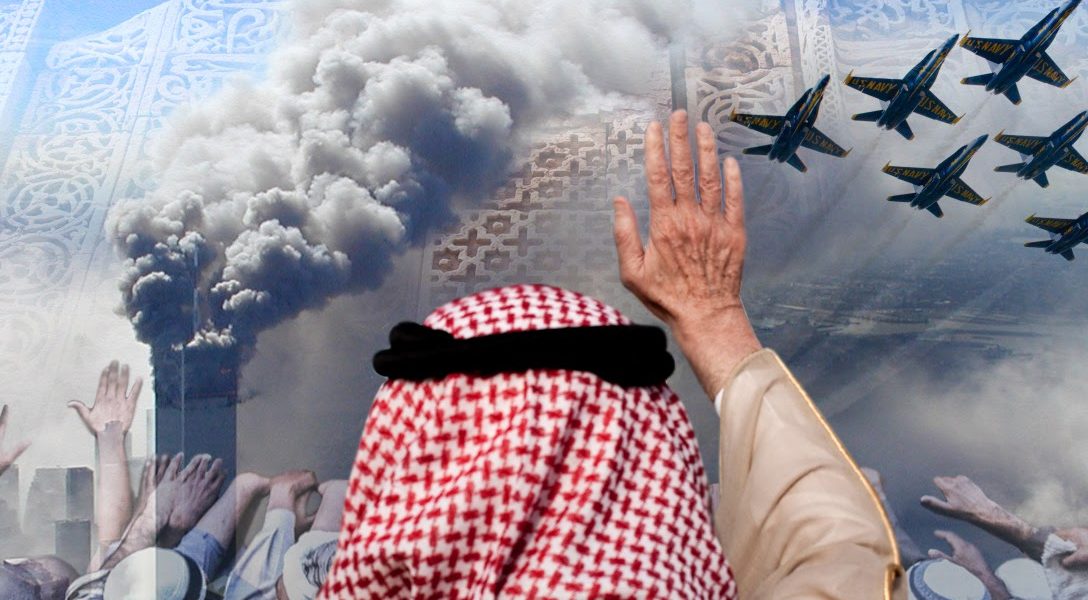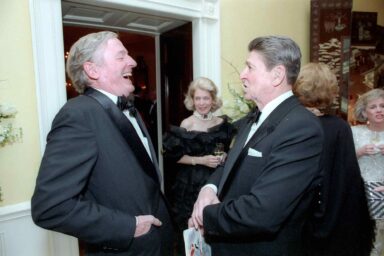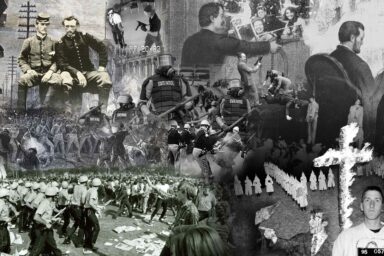Saudi Arabia has poured billions of dollars into promoting Wahhabism around the world, engendering violence from behind the cover of NGOs and government agencies.
In December of last year, the United States suffered the first deadly, internationally orchestrated terrorist attack on its soil since 9/11 — when a Saudi Air Force trainee killed three US sailors and wounded eight others at a Navy air base in Pensacola, FL.
Last week, the FBI and Attorney General William Barr announced that data recovered from the cellphone of the perpetrator further confirms that the mass shooting was an act of terrorism, and that the gunman had ties to al-Qaeda. Was this a discrete act committed in the name of a rogue terrorist organization — or an extension of long-standing Saudi state policy?
On this week’s WhoWhatWhy podcast, journalist Krithika Varagur — author of The Call: Inside the Global Saudi Religious Project — sheds light on this question and discusses Saudi Arabia’s global propagation and funding of Wahhabism. The dominant faith in Saudi Arabia, Wahhabism is a strict form of Islam that demands a literal interpretation of the Quran.
Since the 1960s, Saudi Arabia has invested an estimated $100 billion in the creation of a powerful nexus of charities and organizations that serves as a front for its proselytizing efforts, largely escaping detection until the 9/11 attacks brought attention to Saudi Arabia’s ideological influence around the world.
Varagur explains how Saudi money has infiltrated government agencies and NGOs, establishing a complex infrastructure of personnel and institutions promoting Wahhabist ideology and Saudi “soft power” in such widely dispersed sites as the US, Indonesia, Nigeria, and Kosovo. In recent times, this network has developed into an “intolerance factory” that increasingly engenders global violence.
The illustration above was adapted by WhoWhatWhy from these images: 9/11 Photos / Flickr (CC BY 2.0), Obama White House / Flickr, US Navy, Farid Iqbal Ibrahim / Flickr (CC BY-NC 2.0), and Erik Törner / Flickr (CC BY-NC-SA 2.0).



Click HERE to Download Mp3
Full Text Transcript:
As a service to our readers, we provide transcripts with our podcasts. We try to ensure that these transcripts do not include errors. However, due to time constraints, we are not always able to proofread them as closely as we would like. Should you spot any errors, we’d be grateful if you would notify us.
| Jeff Schechtman: | Welcome to the WhoWhatWhy Podcast. I’m your host, Jeff Schechtman. Back in December, the United States suffered its first deadly attack on US soil since 9/11. It was planned abroad, but no, it wasn’t from a virus. Last week, the FBI said that data from the cell phone of a Saudi Air Force trainee who killed three US soldiers and wounded eight others at a Navy base in Florida back on December 6th, confirmed that it was an act of foreign planned terrorism. Was this a lone act of terror, or was it an extension of Saudi state policy? |
| Jeff Schechtman: | The idea of nations projecting both hard and soft power around the world is not a new idea. It was the bulwark of US policy during the Cold War, and over the past several years, China has done it via its Belt and Road project. Less known, though, is the way in which Saudi Arabia and its particular brand of religious Islam has made it an instrument of state policy, almost invisible until 9/11. The Saudis had a complex infrastructure supported by its oil wealth, to spread Wahhabism throughout Southeast Asia, the Middle East, and Africa. And today, while the Saudi brand may be tarnished, its oil revenues depleted, its influence and legacy are still an ongoing threat. |
| Jeff Schechtman: | We’re going to talk about that in this week’s podcast with my guest, Krithika Varagur. She’s an award-winning journalist who covers Indonesia for The Guardian and has reported widely throughout Asia for publications, including The Atlantic, The New York Review of Books, The Financial Times, and The New Republic. She’s a graduate of Harvard and a Fulbright scholar at the School of Oriental and African Studies in London. She’s the author of The Call: Inside the Global Saudi Religious Project. And it is my pleasure to welcome Krithika Varagur here to the WhoWhatWhy Podcast. Krithika, thanks so much for joining us. |
| Krithika Varagur: | Thank you so much for having me. I’m really excited. |
| Jeff Schechtman: | This project goes back to, really, the ’60s and ’70s. Talk about what it was, how it got started. |
| Krithika Varagur: | Yeah. So, Saudi Arabia, which many people may not know, is a really young country. It only became a country in 1932. Saudi soft power is also a, relatively speaking, recent phenomenon. It started in the 1960s when a Saudi King named King Faisal became the monarch of this kind of young country. And unlike his predecessors, he was really globally-minded, and he came to power during this postwar, mid-century era when there were all these new Asian and African nations. And there were a lot of global alliances shifting and forming at the time, so he had this idea for a foreign policy for Saudi Arabia, which is, of course, the birthplace of Islam, to have a foreign policy driven by Islamic solidarity or [foreign language 00:03:02] Islami. And because of its unique heritage as the birthplace of Islam, he thought that Saudi could be a natural partner for a whole bunch of new countries, from Nigeria to Indonesia. |
| Krithika Varagur: | And he started cultivating relationships with religious leaders all over the Muslim world. Less than 10 years after he embarked on this ambitious people to people exchanges, Saudi Arabia became really rich with oil in the way that we think of it today, and that’s because of the Arab-Israeli War. There was a really massive oil embargo in 1973, which meant that Saudi Arabia, which had already started having pretty serious drilling and so on and had Aramco there, it really became flushed with oil money. The profits quintupled. So, combining this new oil money with King Faisal’s vision for Saudi-led Muslim world, led to this soft power project, which impacted so many countries. |
| Jeff Schechtman: | And talk about what the object was. So often with soft power, we see it being about that nations influence and about the broader projection of its foreign policy. Because this was religious in nature, talk a little bit about the nexus between religion and national power and how the two were tied together. |
| Krithika Varagur: | So, spreading Wahhabism, which is their state religion, became an important part of their foreign policy in the way that spreading democracy was and is the tent pole of American foreign policy. And the reason for this is that the Saudi royal family, the house of Saud, has a centuries old pact with the Wahhabi clerical establishment dating back to the 18th century, where their royal family promised to protect this preacher named Wahhab and his school of clerics if they gave their royal family religious legitimacy in the Arabian peninsula. So, because of this old pact, which is still in place today, the Saudi state, what we might call a secular state, even though it’s kind of a theocratic state, has uptaken the clerics’ goals of spreading Wahhabi Islam worldwide. So, on one hand, Saudi foreign policy was driven by generalized solidarity with Muslims, but another part, because their government’s legitimacy comes from religious clerics, it also means spreading their very specific kind of religion to the countries that they work in. |
| Jeff Schechtman: | And one of the things about this project is how sophisticated it was, how much infrastructure was involved to the point of setting up clerics and all of these countries, and really using all of the financial resources to really engrain itself in so many different places at the same time. |
| Krithika Varagur: | Yeah. That one of my surprising takeaways from the research, which was that it wasn’t this kind of nefarious, like funneling dark money everywhere. At the start, at least, it was really based on personal exchanges, cultivating relationships, often at the highest levels of Saudi Arabia. Like the King himself, King Faisal and also King Fahd, made it a point to identify potential leaders, especially in countries like Indonesia and Nigeria that were geographically far off. So, I think that’s what contributed to the success of this project, which was by no means guaranteed, because his ideology was, in many places, quite extreme. |
| Jeff Schechtman: | The other thing is how long this went on, that it really went on for decades and how wide and how far flung the Muslim world is. |
| Krithika Varagur: | I mean the Muslim world is 1.8 billion people and counting, and Islam is the fastest growing religion today. And the countries they picked are nevertheless outside of what we definitely as Americans tend to think of as the Muslim world. They’re all outside the Middle East. The countries I’ve reported from are Nigeria, Kosovo in the Balkans, and Indonesia, which are really far flung. They are three different continents, but all are basically Muslim majority democracies. And I think that this big sweep of the project is what made it really interesting to study in just [inaudible 00:07:22]. |
| Jeff Schechtman: | Talk a little bit about what this religious belief was, what Wahhabism is all about, and how it was being proselytized. |
| Krithika Varagur: | Yeah. So, Wahhabism is named after its founder, who was a very austere preacher in the Arabian desert named Muhammad ibn Abd al-Wahhab, and basically, he looked around him and saw… He felt that the Muslims of Arabia had lost their way. They were doing all these kinds of practices that were not part of true Islam. They were worshiping at shrines, venerating saints, singing, celebrating the prophet’s birthday. He thought all of this was really off the beaten path, and in this way, he wasn’t, not to believe the comparison, he wasn’t too far off from a Luther. He wanted to reform the practices around him. He had a very austere conception of what Islam really was. What was different for him is that he authorized the use of violence to propagate his vision of what Islam was, and he was kind of unitarian, he really believed that monotheism, there’s no God but Allah was the start and finish point of Islam. But everything else around it was deviant, and people who followed these other kinds of Islam should be excommunicated, basically. |
| Krithika Varagur: | So, from the very beginning, Wahhabism is very combative. It was kind of militaristic. They destroyed shrines, really ancient historic sites. And Wahhabism in practice today is very literalistic religion. A key Wahhabi belief for example is that the earth is at the center of the solar system and not the sun. Wahhabi clerics in Saudi gave a lot of, to us, silly sounding thought was to this day, like one that says people shouldn’t take photos with cats and just all kinds of little things. They’re very concerned with day to day life and daily behaviors, and their very literal and austere conception of what Islam is. That being said, when this religion was exported worldwide, it often ended up as a discreet movement called Salafism and not Wahhabism, per se, because Wahhabism is so site-specific to Saudi Arabia, it really involves this past with the Saudi royal family and obedience to the Saudi Royal family. It doesn’t really make sense into any other country. |
| Krithika Varagur: | So, what happened when they brought this religion worldwide was it created a related movement that encouraged Salafis who end up in the same place as Wahhabis but from a different starting point. Their starting point is that we should emulate the first few generations of Muslims and go back to the earliest Islam, and also, again, reject all kinds of innovations and folk practices. |
| Jeff Schechtman: | And what was the biggest appeal? Why was it so appealing to people? |
| Krithika Varagur: | When imam, who I count as a friend now, in Kosovo, who studied in Medina on a Saudi scholarship, said that growing up in the former Yugoslavia and living through the war, he had a lot of questions. His religious education was really patchy, and he said Salafis had answers. I had a lot of questions and Salafis had answers. The thing that both Wahhabism and Salafism is that because they’re so literalistic and because they rely on a few key texts, like the Book of Monotheism or the Medieval Theologian Ibn Taymiyyah, they do have these cut and dry answers. They have a canon you can memorize. They tend to quote the same sayings of the prophet. And this kind of uniform, simple to understand ideology is really appealing to a lot of people, especially if they come from unstable contexts, which a lot of people in the post-colonial and some post-war context were. |
| Jeff Schechtman: | You talk about how it really thrived and reached its peak, perhaps, during the ’70s with all the infusion of so much Saudi oil money. What happened in the late ’70s as the Islamic revolution came to be? |
| Krithika Varagur: | Yeah. So, that would be, of course, the 1979 revolution in Iran, and that really exploded this project that was already growing in scale and ambition. But then it became this arms race or competition for hearts and minds. The Iranian Revolution really freaked out Saudia Arabia because, first of all, it was Shia and not Sunni. Second of all, it was a popular revolt against monarchy, basically. And both of those things are terrifying to the Sunni monarchy that ruled Saudi Arabia. So, the Iran Revolution happened, and a lot of people in the Muslim world thought this was amazing. They didn’t see it as a Shia victory, per se, they were really inspired by what they had managed to do and installed this Islamist regime. So, a lot of people even started converting to Shiism and countries like the ones I visited, and Saudi really ramped up their proselytization around that time to counter what they felt as this Iranian bit for leadership of the whole Islamic world. |
| Krithika Varagur: | That’s not the only thing that happened in 1979, of course. Is that same year, Islamists within the kingdom occupied the grand mosque in Mecca in what was called Juhayman’s revolt, and they criticized the royal family for deviating from the Islamic path. And, then, they said they’d strayed, and that really struck fear into their hearts, too. So, both domestically and internationally in 1979 had a lot of pressures on Saudi image. And then, the last thing that happened in ’79 was the Soviet invasion of Afghanistan. So, those three things combined really pushed the Saudi project into high gear. |
| Jeff Schechtman: | And one of the things that it seemed to have done when it went into high gear is become so much more violent. |
| Krithika Varagur: | Well, yes and no. Saudi didn’t necessarily want to support terrorists, per se. Nevertheless, it’s become a part of all three countries I reported from, that a small fringe of Salafis becomes Salafi Jihadists. Nigeria, they become Boko Haram, and Indonesia, they become the Al-Qaeda affiliate Jemaah Islamiyah. In Kosovo, several hundred people went to join ISIS. And I don’t think this was by Saudi design, per se, but the fact that their ideology has this real gray area between nonviolent intolerance and violent intolerance. And Saudi will say, “We’re only pushing…” Or agents of Saudi proselytization will say, “We’re only pushing this Salafism, where Wahhabism is not violent.” But the fact remains that you should endorse the things like intolerance, excommunication, deviance, and so on. A vulnerable minority these people inevitably in all these countries become terrorists, so that’s the catch-22 that Saudi found itself in in the ’90s and increasingly in the post 9/11 era. |
| Jeff Schechtman: | And how did 9/11 change this? |
| Krithika Varagur: | Most people wouldn’t have really even known what Islamic fundamentalism was until 9/11, which is hard to believe, I guess, because it’s such a big feature of our world map today. But 9/11 really put, quote unquote, Islamic terror on the map, it made Al-Qaeda a household term, and it really ramped… And of course, 15 of the 19 twin tower hijackers were Saudi nationals, and it was a PR disaster for Saudi Arabia. And Al-Qaeda, of course, was founded by Osama bin Laden, who was from an influential family in Saudi Arabia, but it then turned against the kingdom. So, it was kind of an embarrassing and awful incident, and it turned up the heat on their financial outflows. So, what happened is, even in these nonviolent contexts that I reported from, after 2001, everyone told me that the taps dried up and Saudi wasn’t able to freely give money anymore because there was so much scrutiny on what they were doing abroad. |
| Jeff Schechtman: | As you look back at the legacy of this, in your view, what good came out of it? |
| Krithika Varagur: | Something cool that happened, I think, was it empowered a lot of postcolonial, Islamic intellectuals. I mean, some of the people I spoke to, especially in places like Indonesia, they recount this world of the ’60s and ’70s going to these massive pan-Islamic conferences and youth leagues and so on with great fondness, and I do think that was really cool that it was facilitated for them, regardless of the end results. And it made Saudi into an intellectual destination in the Islamic world where it hadn’t really been one before. If you really think about history, the intellectual capitals of the Islamic world were places like Istanbul, Damascus, Cairo. Saudi was never on the map, and this project really put them on the map because they invested so much in education and so on. |
| Krithika Varagur: | And then, I think, Saudi proselytization did build a lot of schools and universities in places where there were not enough development opportunities at all. And there are plenty of people who took the free Saudi education, maybe even the scholarship, got an education, maybe learned Arabic, and then just went on with their lives. They didn’t become fundamentalists, they didn’t become radicals. And in a lot of the countries, these were invaluable charities. And of course, Saudi charity has also been a really big part of places like Bosnia and Kosovo, [inaudible] after the tsunami and so on, so there’s plenty of what I think are viable Saudi charity efforts, too. |
| Jeff Schechtman: | And how much of this infrastructure is still in place today? There’s certainly less money supporting it and, perhaps, less desire to support it. Where does it stand today? |
| Krithika Varagur: | Yeah. As you said, we’re dealing with the legacy effects today. Some of the brick and mortar things that they’ve built in the peak proselytization era are still standing, so like the Saudi University in Jakarta, Saudi religious attache offices, this big university in Medina. They’re all still there. They’re all still standing. There’s just substantially fewer resources dedicated to them. But also, something I write is that even if Saudi stopped sending any money on proselytization today, their effects would still be considerable, because in all these countries, Salafis are standing on their own feet now. And the internet has been a big democratizing force, and they no longer need active Saudi charity to sustain these communities. So, I think we’re going to be dealing with the legacy effects for a while to come, but definitely, between vision 2030 of the Crown Prince Mohammed bin Selman and the oil crash and COVID-19, it’s going to accelerate this trend we’ve been seeing of lower and lower resources committed to this project. |
| Jeff Schechtman: | How much has Vision 2030 and that project an outgrowth in some respects of what this was? |
| Krithika Varagur: | I mean, Vision 2030 is really a break with a lot of stuff that’s happened in Saudi Arabia. MBS has been testing this pact that I talked about with the Wahhabi clerics to an unprecedented degree, and it’s clear that the reputation Saudi Arabia has acquired in the last couple of decades as this fountainhead of terrorism and so on, is it really affects him and he’s very conscious about it. And he makes a lot of big statements in the public sphere and to Western media like, “We’re going to stamp out extremism. Saudi is going back to its roots. We don’t stand for extremists.” I mean, it’s hard to say what the end result is going to be because we know he’s no defender of human rights. That being said, the fact that he’s conscious about this religious extremism coming out of Saudi Arabia means that he has decreased the resources available to the [dollar?] ministry. |
| Krithika Varagur: | He has arrested quite a lot of Wahhabi clerics and reined them in. He’s passed a lot of laws inside the kingdom that would really antagonize the clerics, they can’t do anything about it because he’s really centralized so much power. And in Vision 2030, only one of the 13 priorities on the blueprint have anything to do with religion, and they only refer to the Hajj pilgrimage and the Umrah pilgrimage. So, he’s really trying to shift gears and show a new face to Saudi Arabia, like economy and tourism and so on. And it’s impossible to tell at this stage, because it’s so early, what the end result of that will be, but I think his uneasiness at the public image is already having pretty significant effects |
| Jeff Schechtman: | And around the world, in the places where this project was so pervasive, is there still simmering resentment to what transpired? We see now, for example, with China and Belt and Road that there’s this resentment welling up. Is there still resentment for what went on? |
| Krithika Varagur: | Yes and no. I mean, I think that a lot of people at the grassroots level in the Muslim world do fundamentally like Saudi Arabia and hope to go there, just because it is the place you do Hajj and pilgrimage, and it’s the birthplace of Islam. But I think, especially as Saudi Arabia’s human rights record has become more and more hard to ignore between Jamal Khashoggi and the war in Yemen and things like that, there’s been a growing chorus of people who are skeptical of Saudi influence. And I lived in Asia for several years as a journalist, they had their own thriving discourse of Arabisasi or Arabization, this idea that Saudia Arabia has corrupted their religious traditions and so on. And the same kind of backlash can be found in a lot of countries. |
| Krithika Varagur: | But I would say that the backlash tends to come from what you might call the liberal or progressive wing of the religious establishment in these countries or from secularists. And there’s often not a huge amount of pushback from the Muslim community at large. So, I think that it can be hard to push back on Saudi influence from a mainstream point of view because the Hajj and so on are so central. |
| Jeff Schechtman: | And finally, talk a little bit about how important it is to understand this, to understand this project, what went on in the ’60s and ’70s in understanding Saudi Arabia today. |
| Krithika Varagur: | Yeah. I mean, I think, first of all, it’s not even understanding Saudi Arabia today, it’s about understanding the world we live in today. It’s a world in which after World War II, it really seems like a lot of these new countries were going to become pluralistic, liberal, progressive democracies. Maybe that was just a flash in the pan, but really for maybe a decade or more, it seemed like Nehru, Sukarno, Nasser, so on, all of these post-colonial leaders were creating new kinds of states. But then, one by one, all of these Muslim majority countries turned out to be quite different. I mean, Indonesia today is democratic, for sure, but religion is absolutely pervasive and intolerance and a more strident kind of Islam that had ever been there in its history before is pervasive in Indonesia today. |
| Krithika Varagur: | In Northern Nigeria, a dozen states have full blown Sharia, and the thing is, did these things happen as an accident? Did these religious and conservative turns happen as an accident? To me, the answer is no. And you can’t understand what happened in any of these countries if you don’t understand the Saudi project and how influential it was. It’s not an accident that this global Islamic consciousness displaced a lot of the progressive and democratic trends of the 20th century, and I think if you understand the Saudi project as this global phenomenon and really apprehend thek reach and the resources devoted to it, you’ll start to see patterns in how these countries developed. |
| Krithika Varagur: | And in terms of Saudi Arabia today, I mean, I think it’s one of the most important countries in the Middle East, for sure, and it’s part of the G20. But the way we talk about their foreign influence has been super vague, and I think this is a consequence of war on terror discourse, which tends to be really black and white and use phrases like axis of evil and so on. I don’t think words like good and evil are useful for people interested in foreign affairs. I was really frustrated, in fact, that we didn’t have a lot of specifics on, quote unquote, Saudi money, even though people talked about it all the time, it was in the 9/11 commission’s report and so on. And I think the best way to fight that vagueness, which leads to bad decisions quite often, is to give a lot of specifics and detailed history. |
| Jeff Schechtman: | Krithika Varagur, her book is The Call: Inside the Global Saudi Religious Project. Krithika, I thank you so much for spending time with us here on the WhoWhatWhy Podcast. |
| Krithika Varagur: | Thank you so much for having me on. This is great. |
| Jeff Schechtman: | Thank you. And thank you for listening and for joining us here on radio WhoWhatWhy. I hope you join us next week for another radio WhoWhatWhy Podcast. I’m Jeff Schechtman. If you like this podcast, please feel free to share and help others find it by rating and reviewing it on iTunes. You can also support this podcast and all the work we do by going to whowhatwhy.org/donate. |
Related front page panorama photo credit: Adapted by WhoWhatWhy from CIA / Library of Congress and Stephen Downes / Flickr (CC BY-NC 2.0).



